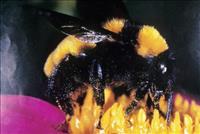
Caption:
Photo by: L. Williams
|
|
Bumble bees
(revision date: 3/29/2025)
Use Integrated Pest Management (IPM) for successful pest management.
Biology
Bumble bees are large, robust, hairy bees. They are early-season, social bees. Several species are native to the Pacific Northwest. While most are variously marked with black and yellow, some have distinctive orange or even reddish patches or stripes. Depending on species and time of year, bumble bees may range in size from around 1/2 inch to over an inch in length. Bumble bees do not overwinter as a colony but instead as single queens. Colonies produce new queens in early July. These young queens mate and then seek an overwintering site. Early the following spring, they emerge and begin searching for pollen and nectar as they establish new colonies. Bumble bee nests are often located in old rodent burrows or nests, cavities in wood, dry grass or leaf litter, vacant birdhouses, or other protected sites. Although bumble bees are among the most docile of bees when foraging, they will aggressively defend their nests if necessary. Unlike honey bees, bumble bees do not have barbed stingers and thus are able to deliver multiple painful stings. Bee stings are potentially dangerous to individuals who are allergic. Seek medical help immediately in cases of known bee sting allergy or if symptoms of allergic reaction occur following a sting (swelling of lips, tongue, or mouth, difficulty breathing, etc.). Bumble bees are able to fly in colder and wetter weather than honey bees, making these insects important pollinators for early spring-blooming crops, especially in the Puget Sound region. Because bumble bees do not reuse old nests, they are less susceptible to diseases and pests than honey bees. However, all bees are extremely susceptible to pesticide poisoning. For more information, see PNW 591 How to Reduce Bee Poisoning.
|
|
Management Options
Non-Chemical Management
- Bees trapped indoors will fly to windows trying to escape. Trap them in a glass or jar against the window and slide a card between the windowpane and jar opening to keep them securely in the jar until they can be released outdoors.
- To encourage bumble bee activity in your garden, select plants to provide pollen and nectar sources early in the spring, when queens are establishing new colonies.
- Do not apply insecticides on or near blooming plants where bees are foraging.
- If insecticides must be applied, remove blooms from plants by mowing or other means, apply insecticides in the evening after bees have stopped foraging for the day, and try to choose products that are less toxic to bees.
Select non-chemical management options as your first choice!
Chemical Management
None recommended.
|
